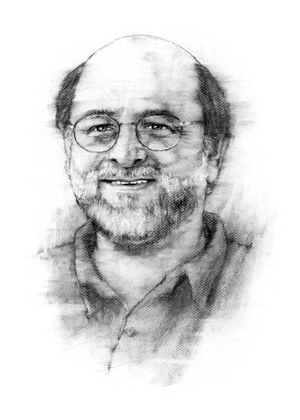|
||
      |
Talking points
 NAME: Daniel Meyer
NAME: Daniel Meyer
TITLES: Associate director, Special Collections Research Center, and University archivist
JOINED SPECIAL COLLECTIONS IN: 1980
DEGREES: AB’72, Valparaiso; AM’75, Chicago (history); PhD’94, Chicago (history)
DISSERTATION: “The Chicago Faculty and the University Ideal”
CITING HIS SOURCE: My dissertation examined how the first generation of Chicago faculty members engaged and reshaped William Rainey Harper’s initial plan for the University. My interest in the topic was generated by working with the archival collections, and the collections also provided the basis for arguing that whatever success Harper achieved, the character of the University was just as significantly defined by the ideals and professional ambitions of his faculty.
UNIVERSAL RESOURCE: Special Collections is used by faculty, undergraduate and graduate students, administrative staff, visiting researchers from other institutions, and independent scholars. Faculty members increasingly present original materials in classes in Special Collections, and a number include assignments based on the archives, sometimes via digital images on course-based Chalk sites. Researchers pursue topics from astronomy and Chicago economics to urban planning and post–World War II cultural politics. Some researchers, like Peter Ascoli, AB’64, working on his recent biography of Julius Rosenwald, spend lengthy periods in the Special Collections reading room. Lab School and Chicago-area high-school students work on Metro History Fair projects, and independent-film producers do research for public television.
HOW CHICAGO STACKS UP: Unlike most state and some private universities, we define the archives to include not only formal administrative records but also professional papers of faculty members, trustees, donors, students, and alumni—anything that bears on the history of the University, its academic programs, and its relationship with the larger community. In addition, the archival collections are physically and intellectually integrated with the manuscripts and rare books in Special Collections. This is an advantage for researchers because it allows them to consult primary-source materials across historical periods, disciplinary fields, and physical formats in a single reading room.
CAREFUL TURNING PAGES: The Rockefeller McCormick New Testament, a Byzantine codex illustrated with a beautiful series of painted miniatures, is among the library’s most valuable manuscripts. It is kept in the Special Collections vault, along with other important rare books and manuscripts, and is one of 67 New Testament manuscripts being digitized as part of the Edgar J. Goodpseed collection. Scholars and classes can use digital facsimiles for study, reducing the handling of fragile originals.
FOR THEIR PROTECTION: Vulnerable items are stored in protective sleeves and custom-built boxes. Many of our earlier items—parchment manuscripts, books and manuscripts on rag paper—are far more durable than later books and manuscripts on highly acidic, brittle pulp paper from the mid-19th century onward. Some of our most fragile manuscripts, in fact, are in modern collections such as the papers of faculty members George Herbert Mead and Ernest W. Burgess, PhD’13. Brittle paper is also scattered through the records of Poetry: A Magazine of Verse, founded in 1912. We provide protective housing for fragile items as we encounter them in processing, and we also secure outside preservation funding such as the Save America’s Treasures grant that helped to rehouse the Poetry collection. Thanks to support from the trustees for a recently completed project, all of Special Collections has been given an improved environment with enhanced controls on temperature and humidity.
ARCHIVES GO HIGH-TECH: Our first two digital collections were developed for the American Memory site at the Library of Congress: American Environmental Photographs, presenting thousands of images of natural ecologies created by the Department of Botany in the early 20th century, and The First American West, which explores the history of trans-Appalachian settlement using rare books and manuscripts from the Durrett collection on Kentucky and the Ohio River Valley. Since then the library’s digital program has created sites based on the University’s centennial exhibitions, world’s-fair publications from the Century of Progress, early printed editions of Chopin, and the papers of Enrico Fermi. We’re also expanding the Archival Photofiles digital collection to include thousands of images of University buildings and the surrounding neighborhood, student activities, athletics, social events, and occasions in University history from conferences to visits by guests such as Edward, Prince of Wales.
RECENT ACQUISITIONS: One of the most fascinating collections we’ve acquired recently is the corporate archive of the Chicago printing firm R. R. Donnelley & Sons Co. The gift spans the history of the company from the years before the 1871 Chicago Fire to the 1990s and includes material on printing technologies, industrial architecture, book design and manufacture, and printing-industry crafts and trades. The archive also documents the range of Donnelley’s printed materials: mail-order and retail catalogs, popular magazines, encyclopedias, and color-printed advertising for department stores and manufacturers of everything from cars and appliances to food products. The collection has great potential for research in social history, graphic design, cultural studies, urban history, and other fields.
JAZZ UP THE ARCHIVES: This year the library’s Chicago Jazz Archive is being consolidated with holdings of the Special Collections Research Center. The Jazz Archive includes materials on the history of jazz in Chicago, jazz recordings, photographs, sheet music, scrapbooks, posters, and memorabilia of jazz musicians and groups. It’s arriving just as we begin UNCAP, the Uncovering New Chicago Archives Project, a three-year initiative funded by the Andrew W. Mellon Foundation. In partnership with faculty members Jacqueline Goldsby, Travis Jackson, and Robert von Hallberg, the library will support the discovery of little-known Chicago archival collections in African American history, training grad students to process them. The grant also underwrites processing of the Chicago Jazz Archive, Chicago Review, records and several modern-poetry collections.
ON THE WISH LIST: The archives have an impressive set of professional papers of faculty members but less about students and student life. It’s sometimes difficult to locate materials from student organizations or photos, posters, announcements, and other items from undergraduate and graduate years. I hope alumni with student memorabilia can help us fill some of these gaps.